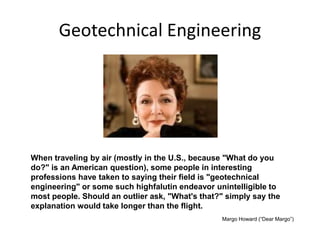About Geotheta
About Geotheta
Blog Article
3 Easy Facts About Geotheta Explained
Table of ContentsGeotheta Things To Know Before You BuyAll about GeothetaThe 4-Minute Rule for GeothetaThe Ultimate Guide To GeothetaAn Unbiased View of Geotheta

They perform site investigations, accumulate examples, execute research laboratory examinations, and evaluate data to assess the suitability of the ground for building and construction tasks - Consulting Engineer. Based upon their searchings for, geotechnical engineers offer recommendations for foundation layout, slope security, preserving structures, and mitigation of geotechnical risks. They collaborate with various other professionals, such as architects, structural designers, and building and construction teams, to make certain that geotechnical factors to consider are incorporated right into the overall job design and application
By examining the actions and residential or commercial properties of soil and rock, they can recognize possible geotechnical hazards such as landslides, dirt settlement, or slope instability. Their competence assists protect against failings or crashes that could threaten lives and building. Below are some in-depth tasks and responsibilities of a geotechnical designer: Site Examination: Geotechnical engineers conduct site examinations to collect information on subsurface problems.
They analyze the information to recognize the residential properties and actions of the soil and rock, including their stamina, leaks in the structure, compaction attributes, and groundwater problems. Geotechnical Analysis and Style: Geotechnical designers evaluate the information accumulated throughout site investigations to examine the security and suitability of the website for building and construction tasks. They carry out geotechnical computations and modeling to assess aspects such as birthing ability, settlement, incline stability, side earth pressures, and groundwater flow.
3 Simple Techniques For Geotheta
Structure Design: Geotechnical engineers play a vital duty in developing foundations that can securely sustain the designated framework. They analyze the dirt problems and load requirements to identify the appropriate foundation type, such as shallow structures (e.g., grounds), deep structures (e.g (https://www.openstreetmap.org/user/geotheta)., stacks), or specialized methods like soil improvement. They consider elements such as negotiation limitations, birthing capability, and soil-structure communication to create ideal foundation layouts
They evaluate building and construction strategies, display website activities, and conduct area evaluations to confirm that the style referrals are adhered to. If unpredicted geotechnical concerns occur, they analyze the scenario and supply recommendations for remediation or modifications to the layout. Danger Analysis and Reduction: Geotechnical engineers examine geotechnical threats and threats connected with the job site, such as landslides, liquefaction, or soil disintegration.

Collaboration and Interaction: Geotechnical engineers function carefully with other experts associated with a job, such as architects, architectural engineers, and building teams. Effective communication and partnership are important to incorporate geotechnical factors to consider right into the general project style and construction procedure. Geotechnical designers provide technical know-how, answer questions, and make certain that geotechnical demands are met.
Geotheta for Dummies
Here are some kinds of geotechnical engineers: Foundation Engineer: Structure engineers specialize in designing and evaluating foundations for frameworks. They examine the dirt conditions, lots requirements, and website qualities to figure out the most ideal structure kind and style, such as superficial foundations, deep foundations, or specialized methods like heap foundations.
They examine the aspects influencing slope security, such as dirt buildings, groundwater conditions, and slope geometry, and create techniques to avoid incline failures and reduce threats. Quake Engineer: Earthquake engineers concentrate on evaluating and developing frameworks to stand up to seismic forces. They analyze the seismic risk of a site, assess dirt liquefaction capacity, and develop seismic style standards to make sure the safety and resilience of frameworks throughout quakes.
They do area testing, accumulate examples, and analyze the gathered data to define the dirt residential properties, geologic formations, and groundwater conditions at a website. Geotechnical Instrumentation Engineer: Geotechnical instrumentation engineers concentrate on tracking and gauging the habits of dirt, rock, and frameworks. They set up and keep instrumentation systems that monitor aspects such as dirt negotiation, groundwater degrees, incline activities, and structural displacements to analyze efficiency and provide early cautions of prospective issues.
Geotheta Can Be Fun For Everyone
They perform tests such as triaxial tests, consolidation tests, straight shear examinations, and leaks in the structure tests to collect information for geotechnical evaluation and style. Geosynthetics Designer: Geosynthetics engineers focus on the design and application of geosynthetic products, such as geotextiles, geogrids, and geomembranes. They make use of these products to boost soil stability, strengthen slopes, supply drainage options, and control disintegration.
They have a tendency to be investigatory individuals, which implies they're intellectual, reflective, and investigative. They wonder, systematic, reasonable, logical, and logical. Several of them are additionally social, indicating they're kind, charitable, cooperative, person, caring, helpful, empathetic, tactful, and pleasant. Does this sound like you? Take our cost-free job test to learn if geotechnical engineer is among your leading career suits.
In read this article the workplace atmosphere, geotechnical designers make use of specialized software program tools to carry out computations, create styles, and assess data. They prepare reports, review task requirements, interact with customers and group participants, and coordinate project tasks. The office setup provides a conducive environment for study, evaluation, and collaboration with other specialists associated with the task.
Geotheta - An Overview
They frequently see project websites to carry out site examinations, assess geotechnical conditions, and collect information for analysis. These check outs include taking a trip to various places, occasionally in remote or challenging surfaces. Geotechnical designers might do soil tasting, conduct tests, and monitor building and construction activities to guarantee that the geotechnical elements of the project are being implemented correctly.
Geotechnical designers likewise function in specialized geotechnical laboratories. Geotechnical research laboratory engineers work extensively in these atmospheres, managing screening devices, running tools, and recording data.
Report this page